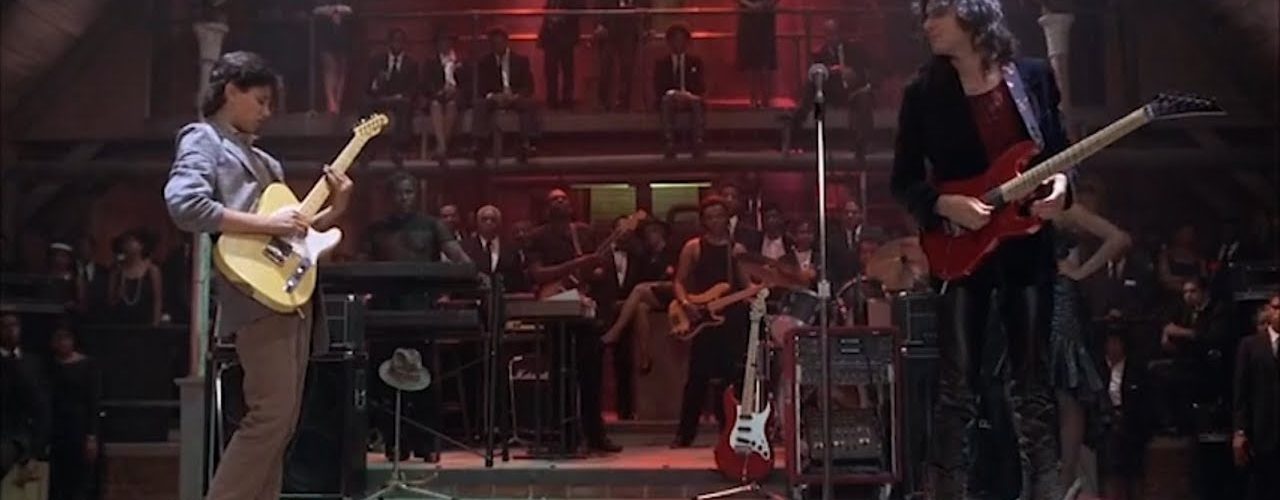Video length: 6 minutes 26 seconds
Artist website: vai.com
Musicians
Steve Vai as Jack Butler – electric guitar
Ralph Macchio as Eugene Martone – electric guitar
Joe Seneca as Willie Brown – harmonica
Unfortunately, I don’t know the names of the other actors/musicians involved in this music scene. The rest of the evocative soundtrack for the movie has been performed by such guitar greats as Ry Cooder, Arlen Roth and William Kanengiser.
What makes this video great and what can you learn from it?
- a guitar duel as the climax of a movie
- a diabolical performance by Steve Vai
- Steve Vai unable to play something, which doesn’t happen in real life
What can you learn from the article?
- a brief Crossroads story synopsis
- the Paganini Caprice #5 theme that’s the basis for “Eugene’s Trick Bag” in tablature
- learn to play horizontal 3rds in the E Mixolydian scale
- how to master the spectacular horizontal triad shifting that occurs towards the end of the piece
- how to play a diminished 7th arpeggio in a sequence of 4s
- melody & feel vs. chops & technique
- learn to play “Eugene’s Trick Bag” more easily with the help of an animated tab video
Key Moments in “The Crossroads Guitar Duel Scene”
| technique/concept | video timestamp |
|---|---|
| Trill | 3:40-3:50 |
| Harmonic minor arpeggio sequence | 3:51-4:05 |
| Paganini’s Caprice #5 theme | 4:06-4:14 |
| Horizontal descending Mixolydian 3rds | 4:14-4:17 |
| Horizontal root position triad shifts | 4:17-4:33 |
| Neoclassical diminished 7th arpeggio sequence | 4:33-4:36 |
| Power chord tremolo picking | 4:38-4:40 |
| Same note octave lick | 4:40-4:42 |
| Four octave harmonic minor run & picardy third | 4:43-4:50 |
| Vai mistakes & guitar drop | 5:07, 5:18, 5:27-5:33, 5:38, 5:57 |
Here’s a quick rundown of the Crossroads story background leading up to the duel scene. Eugene Martone (played by Karate Kid Ralph Macchio) is a Classical guitar student at the prestigious Juilliard School of Music. He is also into Blues and dreams of becoming a Bluesman. He gets to know Willie Brown and helps him escape from an old folks prison facility so Willie can settle some unfinished business in Mississippi. As a reward for helping him escape, Willie promises to teach Eugene a supposedly lost song by the legendary Blues guitarist Robert Johnson.
During the journey Eugene learns that Willie sold his soul to the devil at the crossroads and regrets the deal. He wants to redeem Willie’s soul and makes his own deal with the devil at the same crossroads. All Eugene has to do is to win a guitar duel against Jack Butler, the devil’s guitarist of choice (none other than Steve Vai, in a truly diabolical performance). Easy, right?
The Duel Warm-Up
Like two boxers circling each other before a fight, Eugene and Jack trade off licks trying to measure up the opponent’s skill. After the 1st set of phrases fails to intimidate Eugene, Jack kicks into the main part of the duel with a high-octane improvisation over a Blues progression (at 1:53). He includes all the guitar acrobatics you’d expect from him: alternate picking runs, legato phrases, pinch harmonics and whammy dips (at 3:16) and additional whammy extravaganzas. Eugene holds his own at first, but the final cadenza seems to settle the duel in Jack’s favor. At 3:30 all seems lost and Willie Brown hangs his head in resignation with the devil grinning because of winning yet another soul.
Trill to Win
However, Eugene does not give up that easily. He launches into a trill to re-capture the audience’s attention. This trill demands a lot of strength and is a great technical work-out for your 3rd and 4th left hand fingers.

Quick cheat tip: use tapping to make the trill easier. This reduces the work load for the left hand considerably. Simply tap the 5th fret C note with your right hand. You won’t get the 4th finger work-out benefit, but you’ll reach the original tempo of the piece much faster.
Trill to win: 3:40 – 3:50 – back to overview
Harmonic-Minor Arpeggio Sequence
After the trill, “Eugene’s Trick Bag” starts for real with a series of arpeggios derived from the harmonized A harmonic minor scale.
| Am | E7 | A7 | Dm | G#dim7 | Am |
| I (m) | V7 | V7/IV (m) | IV (m) | VII dim7 | I (m) |
The A7 chord functions as a secondary dominant chord, meaning it’s not actually in the original key. In the key of A harmonic minor we’d expect a minor chord on A, so A7 changes the chord quality and increases the tension. Since the A7 functions as a dominant 7th chord of Dm – the chord it resolves to – this works out rather nicely.
There are multiple approaches possible when playing this passage. You can use alternate picking throughout, alternate picking at the core with hammer-ons and pull-offs interspersed when changing direction or to make specific passages sound more connected. If you are into sweep/economy picking there’s nothing wrong with using those techniques as well. Just make sure that your timing doesn’t get sloppy when sweeping across multiple strings.
Harmonic minor arpeggio sequence: 3:51-4:05 – back to overview
Paganini’s Caprice #5 Theme
Eugene shows his Classical influence by quoting Paganini’s Caprice #5 main theme. This bar (the complete theme respectively) is an awesome alternate picking work-out that demands a lot of left hand fretting precision and definitely helps to build up left-right hand-coordination. It’s also quite fun to play once you get the hang of it.
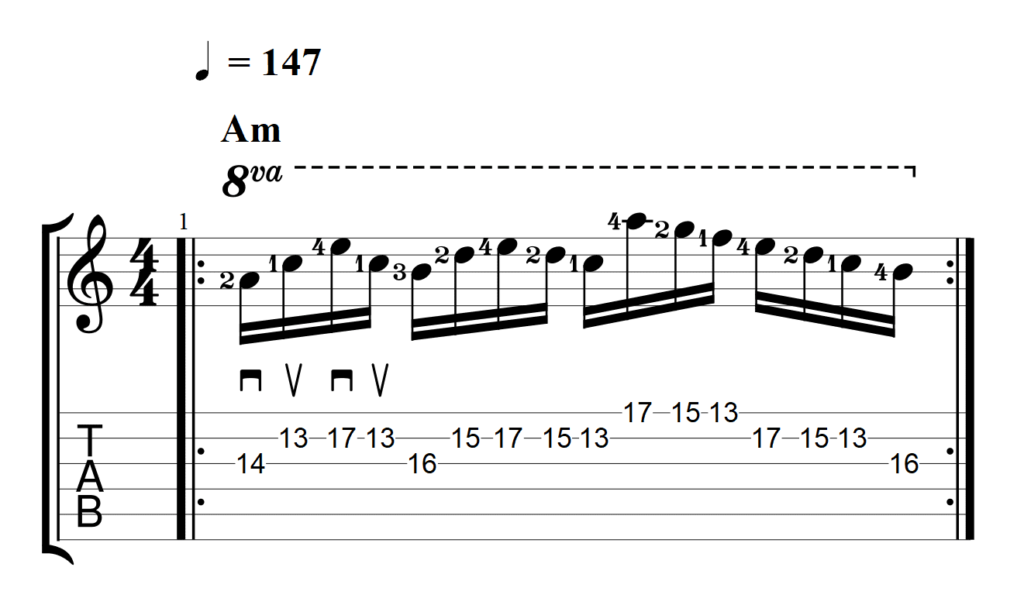
I don’t know if the producers intentionally chose to prominently feature a Paganini theme at the core of “Eugene’s Trick Bag,” but it’s a great choice. Niccolo Paganini, who lived from 1782-1840, is considered to be one of the greatest violin virtuosos of all time. Due to his superhuman technical skills there were many rumors about Paganini’s association with the devil and that he’d struck a deal with him to gain his incredible technique. So, performing a theme by a (rumored) devil’s disciple in a duel against a devil’s protege adds a sophisticated touch to this scene.
Paganini’s Caprice #5 theme: 4:06-4:14 – back to overview
Horizontal Descending Mixolydian 3rds
After the Paganini theme section there’s a temporary time signature change (one measure of 6/4 or two bars of 3/4, however you’d like to look at it) featuring descending 3rds in the E Mixolydian scale. This is definitely an idea that you can (and should) incorporate into your own playing. You can apply it to many styles and it’s not that difficult to master. If you keep your left hand 2nd finger as your anchor on the B string, you simply need to make the adjustments between minor 3rd and major 3rd intervals.
Here is the E Mixolydian scale mapped out for you in 3rds across the top two strings. Practice this idea in all the keys horizontally up and down the neck. Hint: once you’ve mastered the 3rds, branch out into all the other intervals. Horizontal intervallic playing is a killer technique to have in your toolbox.
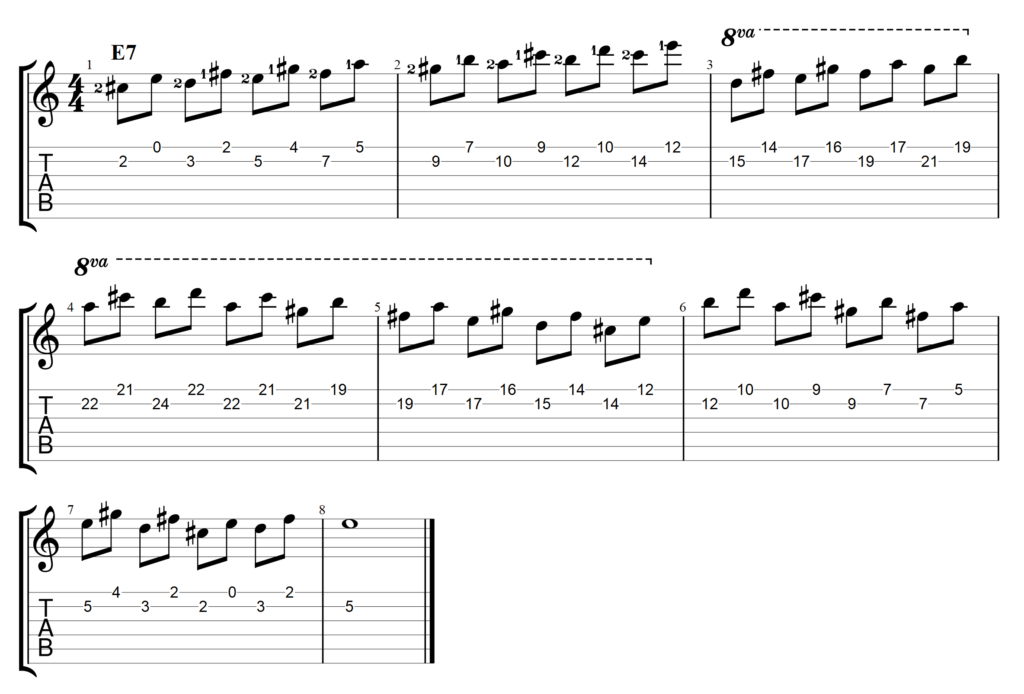
Horizontal descending Mixolydian 3rds: 4:14-4:17 – back to overview
Horizontal Shifting of Root Position Triad Shape + Open E-String
This probably is the most spectacular section of the piece. The main challenge is to not get lost during the rather large position jumps of up to an octave later in this segment. In case you want to learn “Eugene’s Trick Bag”, make sure to practice this section slowly. You need to program your fingers correctly. Always try to look ahead to where your fingers need to jump to.
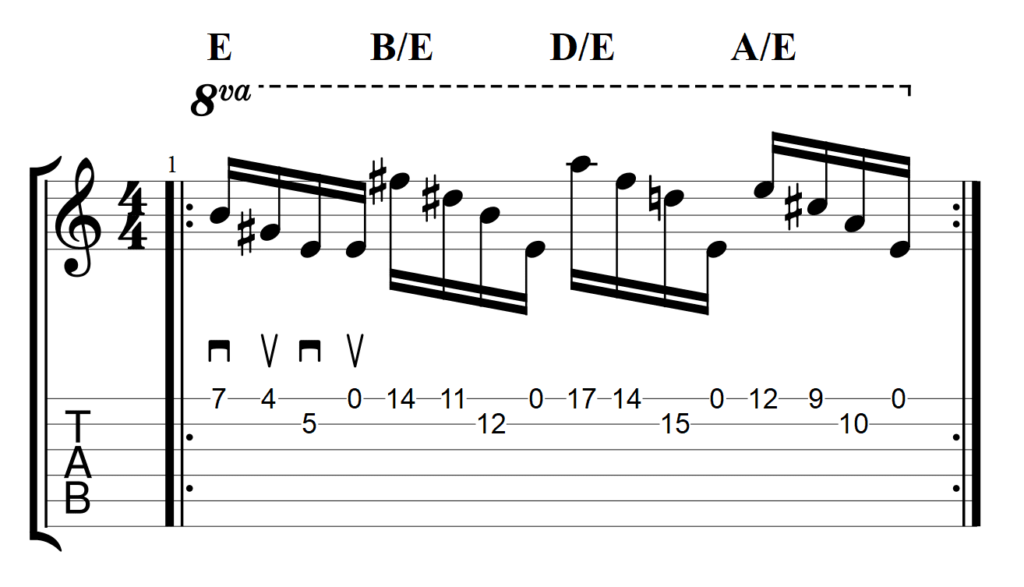
On the plus side: the left hand fingering stays constant throughout this section. Basically, you are “simply” moving the same root position triad around the neck. The open high E string, which ends each group of 16th notes, not only facilitates the position shifts, but also ties the sequence together with a common note while providing tension for some of the arpeggios. Talk about bang for the buck.
This segment could serve as yet another great alternate picking work-out, however check out this alternative. Using a pull-off in combination with some economy picking you can reduce your picking workload which might let you focus more on the required position shifts. The initial upstroke might feel a little weird initially. But once you have gotten over the “shock” of using an upstroke on a downbeat, you’ll find that this pattern has a nice flow. Give it a try.
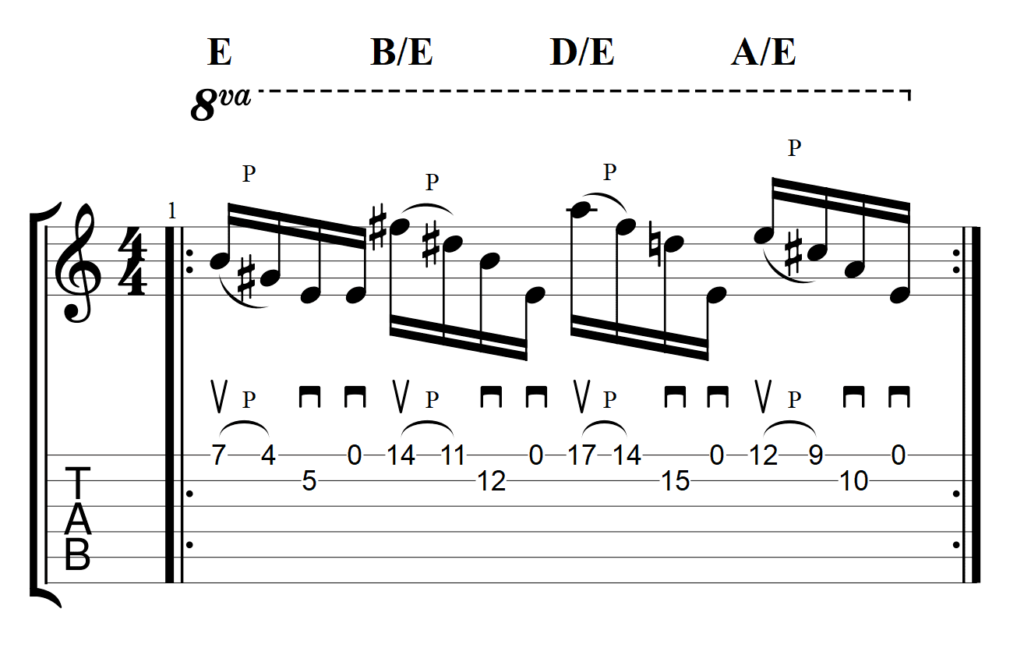
Horizontal root position triad shifts : 4:17-4:33 – back to overview
Neoclassical Diminished 7th Arpeggio Sequence
No Neoclassical piece would be complete without a diminished 7th arpeggio. Nothing too fancy here. A two measure descending group of 4s type of run. G#dim7 functions as a substitute for E7. Let’s analyze the notes of the G#dim with an E chord in mind.
G#dim7 consists of the notes G#, B, D and F. G# is the 3rd of an E chord, B is the 5th, D is the b7 and F is the b9. So, by playing a G#dim7 chord or arpeggio you are implying an E7b9 chord. This is perfect for this harmonic situation – the tension is increased and the resolution to the I chord A feels even bigger. Mission accomplished.
| 1 | 3 | 5 | b7 | b9 | |
| G#dim7 | G# | B | D | F | |
| E7 | E | G# | B | D |
Here’s the sequence notated/tabbed out for you:

Neoclassical diminished 7th arpeggio sequence: 4:33-4:36 – back to overview
Power-Chord Tremolo Picking
Notice the tremolo picking of the power chord. This adds some movement and excitement and keeps the momentum going. It’s somewhat reminiscent of surf guitar, which might be a weird association, but that’s what it reminds me of.
Power chord tremolo picking: 4:38-4:40 – back to overview
Same Note Octave Idea Lick
This Steve Vai staple is a great idea to practice just for the sake of improving your knowledge of the fretboard. Include this idea into your warm-up routine and pick a different note each time. Over time this will do wonders to your confidence of where all the notes are located.
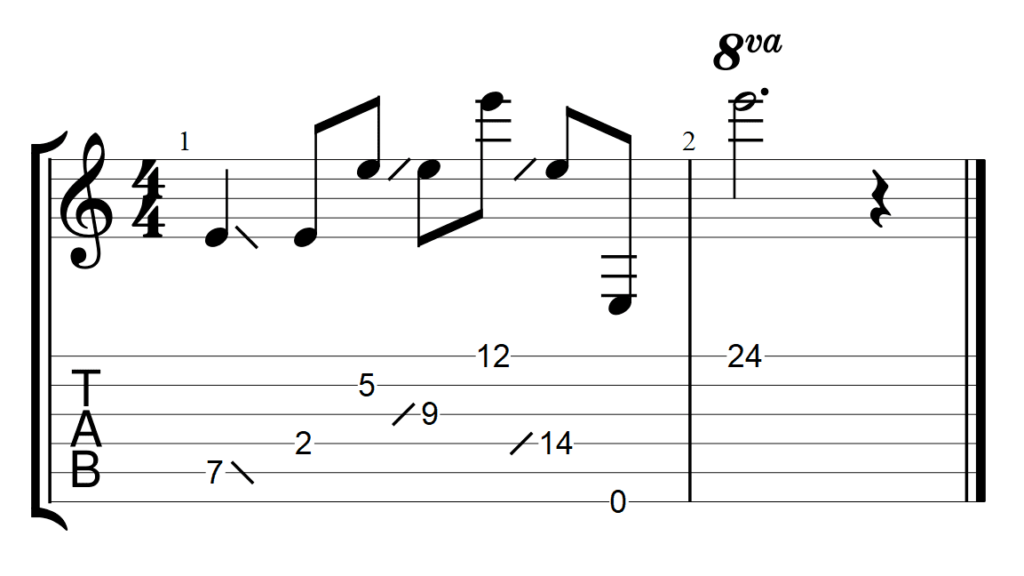
Same note octave lick idea: 4:40-4:42 – back to overview
Four-Octave A-Harmonic-Minor Run & Picardy Third
The final run of the piece is a four-octave A-harmonic-minor scale. Ok, the initial three and a half octaves are not that big of a deal, even though Steve seems to struggle with it in the movie. Once it goes beyond the high E note though, things do get really difficult.
The celestial harmony effect on the last note must have been an overdub. It’s almost impossible to nail that last note in live playing. I’ve read that Mr. Vai supposedly played this note by pushing the E string against the polepiece of the bass pickup. How crazy is that? Also, (almost) no chance of playing that harmonized picardy third in one go.
Btw, you should definitely add “picardy third” to your musical vocabulary. Basically it’s nothing more than a fancy term for when a minor piece ends with a major chord instead. Nothing complicated but it does sound impressive, right?
Back to solving the issue with the last note. A bottleneck slide could help you get to that final high point. Also, switching on some sort of harmonizer effect could do the trick. Probably the easiest, but least dramatic solution, is to simply drop the last note down an octave to have a solid ending in place without any fancy gimmicks getting in the way.
Four octave harmonic minor run & picardy third: 4:43-4:50 – back to overview
Finally, Vai is Human After All and Makes Mistakes
It must have been tough for Steve Vai to pretend NOT to be able to play those parts where he eventually failed. The stuff he played earlier actually was way more difficult. Even though those mistakes were part of a scripted movie, bookmark this page for reference. Whenever you are struggling with anything on the guitar and are seriously close to desperation and/or depression, have a look at the following list and remind yourself that even Steve Vai made mistakes. That should help make you feel better about yourself. Ha, take that, Steve!
| video timestamp | description |
|---|---|
| 5:07 | Steve Vai makes the 1st mistake. |
| 5:18 | Vai stumbles again. |
| 5:27 & 5:33 | Steve can’t finish the harmonic minor run. |
| 5:38 | Game over! |
| 5:57 | The final guitar drop. |
Vai mistakes & guitar drop: 5:07-5:57 – back to overview
Conclusion
Melody & Feel Vs. Chops & Technique?!?
All of Steve’s guitar acrobatics are nicely countered by bluesy slide licks, because melody and feel are powerful elements of music. However, notice how all the Classical training and discipline culminating in the Paganini influenced piece “Eugene’s Trick Bag” saves the souls of Eugene Martone and Willie Brown. So, the Crossroads producers didn’t take the easy route of bashing technique and chops and putting feel and bluesy licks on a pedestal. Technique is important and has its place as well. Ideally, you develop all the chops and technique to express your feelings in a melodic way on your instrument.
Back in the late 80’s I wore out at least 2 VHS tapes of the movie just watching the famous guitar duel scene. Watching, rewinding, watching, rewinding…. Call me nostalgic (which I very well might be) but Crossroads did quite a few things right. Lots of Blues folklore elements included in the story leading up to a legendary guitar duel between Karate Kid and Steve Vai.
Crossroads is well worth checking out for all the guitar scenes sprinkled throughout the movie, but this scene alone would have justified the whole movie. Most “mature” guitar players, meaning people older than millenials, will most likely already have seen this scene repeatedly. Anyone else can now rectify this omission.
And finally, don’t go into a guitar duel with Steve Vai unless it’s a scripted movie and you know how to play “Eugene’s Trick Bag.” To help you achieve this and to be prepared for such an occasion, here’s the piece again. This time including on-screen tablature.
Related websites
https://www.arlenroth.com/crossroads
Sources
Guitar Techniques 1994/11
Guitar Techniques 2008/11
Paul Hanson – one of my instructors at both A.I.M. in Vienna and M.I. in Los Angeles. Thanks for teaching me how to play this piece back in the early 90s.
Get notified whenever I publish a new article!
Absolutely NO Spam – Unsubscribe Anytime.
